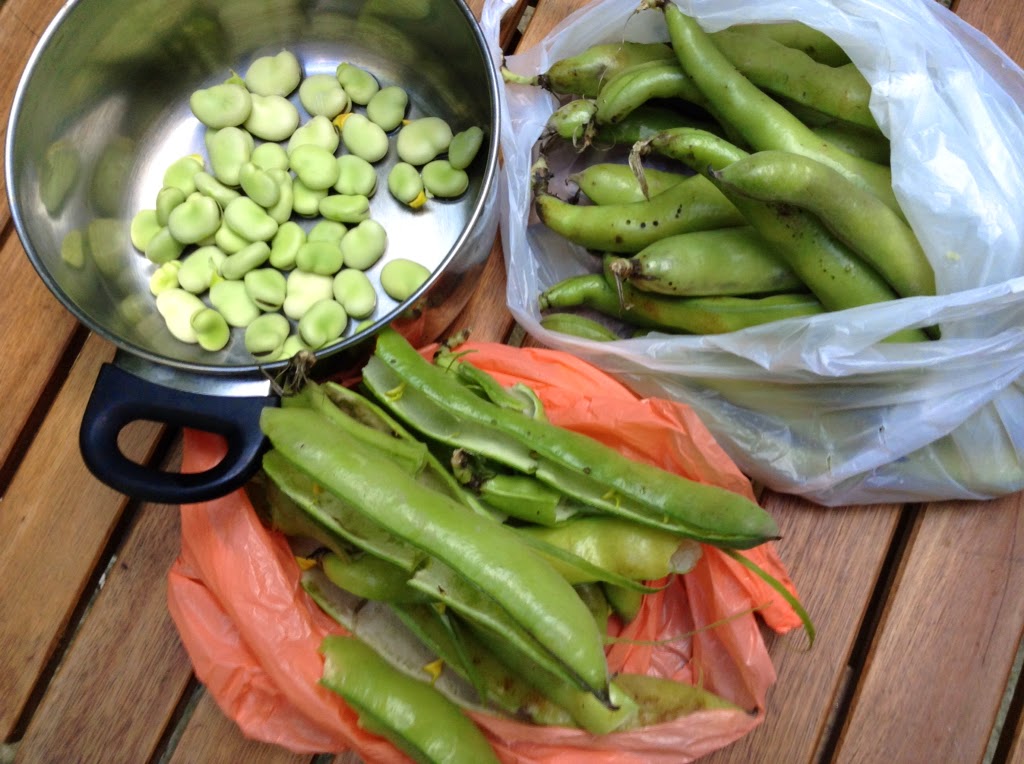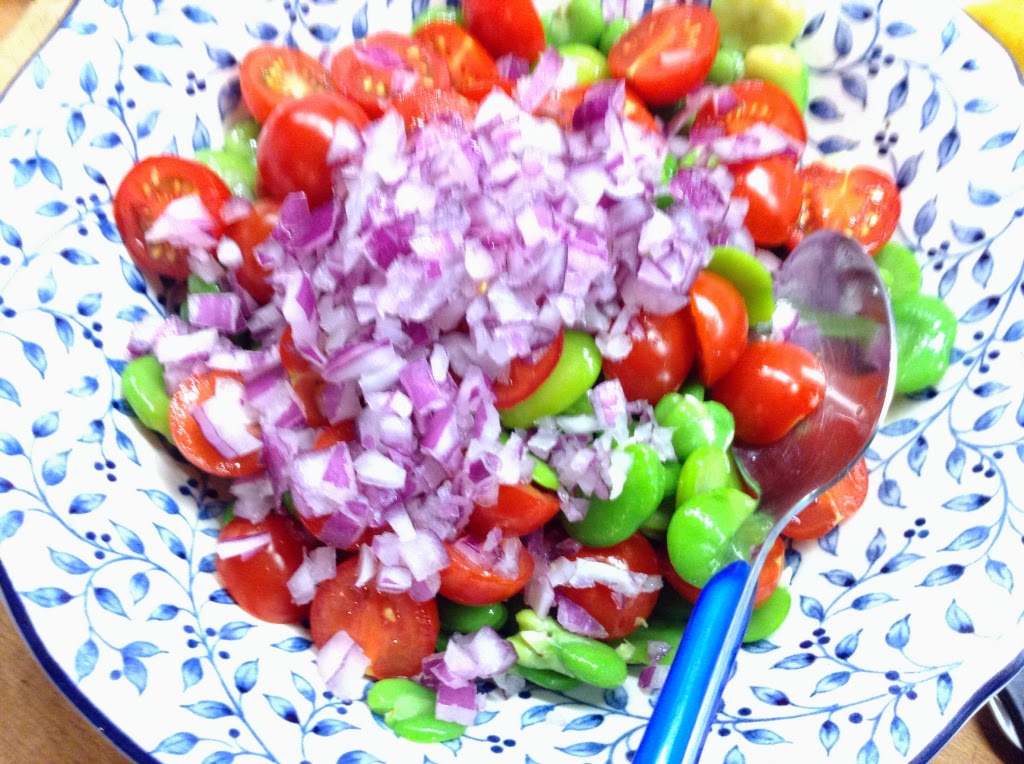While our vacation travels are often too busy to be relaxing, they do rejuvenate by interrupting routines, offering new perspectives. These perspectives often show up in small quotidian ways; I use my clothes dryer even less ever since a trip to Portugal nudged me back towards more reliance on the simplest use of solar power, several years ago, for example.
Most often, these small changes happen in the kitchen. One of the pleasantest ways I can think of to bring a vacation back home is to emulate meals enjoyed in faraway places. To that end, I’ve ordered a copy of The Puglian Cookbook for Paul, who’s keen to try out some of the simple, fresh, delicious dishes we ate in Peschici. But in the meantime, we’re rekindling memories of our Bordeaux kitchen by making up a favourite salad we ate there several nights, after delightedly discovering fresh fava beans at the local outdoor markets.

In this case, rather than trying to recreate a dish typical of the region, we’re conjuring the region through memories of a recipe we brought to ingredients we found there. Fava beans are difficult to come by in our local Thrifty’s grocery store, although they can occasionally be found, in season, at Farmers’ Markets. But we found them several times for anywhere from 1.5 to 3 euros a kilogram in Bordeaux and happily filled our bags.
We’ve developed a pattern during our Bordeaux weeks (of which we have now been fortunate enough to have 6 or 7 over the past 3 years): we tend to have our bigger meal of the day at lunch, in a restaurant, accompanied by a demi-bouteille of wine. We will often choose from the formule menu, and thus include a dessert after the meal, as well as an entrée before our main. So for dinner, something lighter (although still accompanied by a glass or two, bien sûr).
And part of the pleasure of our time in Bordeaux is that, removed from the demands and obligations of life at home, we are nonetheless able to integrate some of the daily domestic pleasures that deserve to be savoured. So simple foods processed by hand, slow food, but slow, simple summer food, food whose handling reminds us of all our senses. Fava beans, that must be stripped in stages. My fingers still recall the waxy squeak of their pods as I break them open, that crunching sound that acompanies the break, the fine mist of juice that escapes with that snap, a fresh, green bouquet. In an arc of my wrist, a pinching together of my right thumb and pointing finger, I remember the precise tension of the green fibrous “string” that unzips to reveal the beans themselves, lined up neatly within the long, rather coarse pods.
Shelling a kilogram of pods takes about ten minutes, and one might be discouraged to see how small the haul, especially knowing that the beans need more processing, and will give over even more fibre to the compost pile before we’re done. But in Bordeaux, those ten minutes were spent in a sunny cloistered garden, and working all that green matter through my hands, into the compost bin, made me feel part of a local ecology, if just for an afternoon or two.

As I said, removing the beans from their gousses, labour intensive though that might be, is not the end of our work here. The beans must first be cooked in salty water (add them by handfuls to water already at a rolling boil, give them a minute or two to rise to the top, and then place them into a bowl of ice water) and then squeezed out of their jackets, one by one. Again, the work is rewarded by sensory pleasure, in this case, the revelation of the sweetest, sweetest green. And the undeniable childish pleasure of the squish and pop, sometimes even the flight of a bean across a counter, under a chair.

In the photo below, I’m showing you the empty cases (in the top container) and the tender green beans, cooked and ready for our recipe.

I’ll let Paul demonstrate for you. The recipe is an amalgam of one we found on the web; there’s considerable latitude for your own version… Paul diced about 1/2 a red onion, adding them to the beans with a tige (branch, stem) of cherry tomatoes, halved.


At some point, he added the juice of a lemon

And he obviously knew the salad would taste better if made and served in the prettiest bowl possible.
He also added half a chopped, peeled cucumber and perhaps 1/4 cup of a chiffonade of parsley. Then tossed it altogether with some seasoning (your choice, but you might go Moroccan with cumin, possibly switching out the parsley for mint).
One night, when we hadn’t been able to find any fresh fava beans, we substituted canned. Not quite as good, no, but still a fine, easy salad. Another variation is to add chopped fennel bulb. Your imagination is the limit, really.

We enjoyed our salad with the best bread we could find, complemented by that day’s cheese selection from the cheese shop around the corner. A glass of rosé, sometimes a follow-up of a chocolate-covered Petit Ecolier biscuit, and then a cup of tea and a good book. The last three items made our holiday spot feel more like home. And now, when we adjust this meal to our kitchen on the island, we’ll be pulling a bit of Bordeaux into our lives back here. This integration is important to me as we travel back into the quotidian….

Do you find the same thing? Do you import new habits from the places you visit, both changing and changed by them? What meals have you brought to vacation spots, and which have come home with you? Or are the changes you make happening in other aspects of your daily lives? And finally I’m curious, are fava beans easy to find where you live? Do you think they’re worth the prep time? Any good substitutes to suggest?
Oh, that's making my mouth water!! I love fava beans and haven't had them in ages. May have to hunt some down this weekend and try my hand at that salad. I love those culinary souvenirs.
I'll be curious to know how easy/hard they are to find where you are.
The colour of the beans and of the tomatoes are truly lovely.I'm going to make this salad.
Isn't it a pretty salad? I'd love to know how your enjoy yours.
To return home unchanged in some little way is to miss the point of travel, n'est-ce pas? I love this tie to your time in Bordeaux and I'm certain that every time you make this salad or a variation, your mind will return there. Such lovely colours and textures.
On a very hot day in Provence we took a wine tour. One of our tastings was of an icy cold Beaumes de Venise muscat. The sweet mingled with the sharp and the cold and I was smitten. I've found, on occasion, the same wine from that vineyard here and it always evokes memories of that day in Provence.
Those are lovely memories, Lorrie. We tasted a beautiful moscato at a winery my sommelier daughter-in-law took us to in Puglia — so I can imagine yours and I can imagine how marvelous it must be to find and drink it again at home.
I haven't traveled as you do – staying there, living there, so I haven't brought back life stuff as you do. It's a lovely idea. San Francisco does love its fava beans, but we eat them mostly in restaurants:).
I'd say the same for Vancouver, although I think the old European immigrants still grow them in backyards across the city. ..
Fava are known as broad beans here in Oz and used to be easily found fresh in season but have fallen out of favor in recent years. They are still available frozen all year round. When very young and new you can skip the double podding. Later, when they start to get a bit mealy, they are good mashed with olive oil and garlic or chili and used as a spread on bruschetta.
Every summer I make a salad we had first had somewhere in France. Steamed young potatoes mixed with a little mustardy mayonnaise, quartered tomatoes, boiled eggs, black olives, steamed green beans and ham batons served on a bed of butter lettuce.
It was in southern Spain I first had soft cheese drizzled with truffle honey, so good everyone else at the table had to share it. In Sicily they often serve their gorgeous chestnut honey in a little dish with a platter of hard cheeses. So simple and delicious, I often have it now for lunch but would never have thought of putting the two together.
Lilibet
I'm going to have to grow some, so that I can try them when they're that young. I did end up mashing a bunch of the bigger ones a year or so ago when I found them in my home town — but here, they're so much more expensive!
I love the sound of that salad that evokes France for you. But that cheese and truffle honey, Mmmmmm. And I'll take that plate of hard cheese (some from sheep, I'm guessing, even better) with the chestnut honey as well. Thanks!
I sense I do but it's hard to quantify it. I brought back with me a Sicilian salad of oranges, olive oil, dry olives and chili flakes (from NYC). I learned to perfectly chill a red. I will learn to make valenciana paella. I try to take a lesson from every place but it doesn't always work.
It is hard to quantify, because it's often broader or more subtle than a single dish, but yes, this is what I mean. I'm sure you'll end up with an awesome paella in your repertoire. (Paul took that on quite a few years ago, and we have paelleras in every conceivable size….